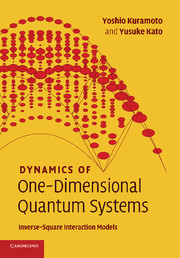1 - Introduction
Published online by Cambridge University Press: 12 January 2010
Summary
Interactions in many-body systems bring about collective phenomena such as superconductivity and magnetism. In many cases, simple mean-field theory provides a basic understanding of these phenomena. In fermion systems in one dimension, however, neither the mean-field theory nor perturbation theory works if it starts from the non-interacting fermions. This is because the interaction effects in one dimension are much stronger than those in higher dimensions. Intuitively speaking, two particles cannot avoid collision in a single-way track in contrast with two and three dimensions. Thus the interaction effects appear in a drastic way in one dimension.
Another aspect in one dimension, which overcompensates the difficulty of perturbation and mean-field theories, is that a complete account of interaction effects is possible under certain conditions. The class of systems satisfying such conditions is referred to as exactly solvable. Soon after the establishment of quantum mechanics, Bethe solved exactly the Heisenberg spin model in one dimension [28]. The basic idea of the solution is now called the Bethe ansatz. Since then, theoretical physics in one dimension has developed into a magnificent edifice, including sophisticated mathematical techniques. In many cases, the eigenfunctions derived by the Bethe ansatz consist of plane waves that are defined stepwise for each spatial configuration of particles. Since the coefficients of plane waves depend on the configuration, the property of the wave function cannot be made explicit without detailed knowledge of these coefficients. We mention some of the recent monographs on the Bethe ansatz and its extensions [54, 118, 179]. A comprehensive account on exactly solvable models has recently been given by Sutherland [178].
Information
- Type
- Chapter
- Information
- Dynamics of One-Dimensional Quantum SystemsInverse-Square Interaction Models, pp. 1 - 18Publisher: Cambridge University PressPrint publication year: 2009
